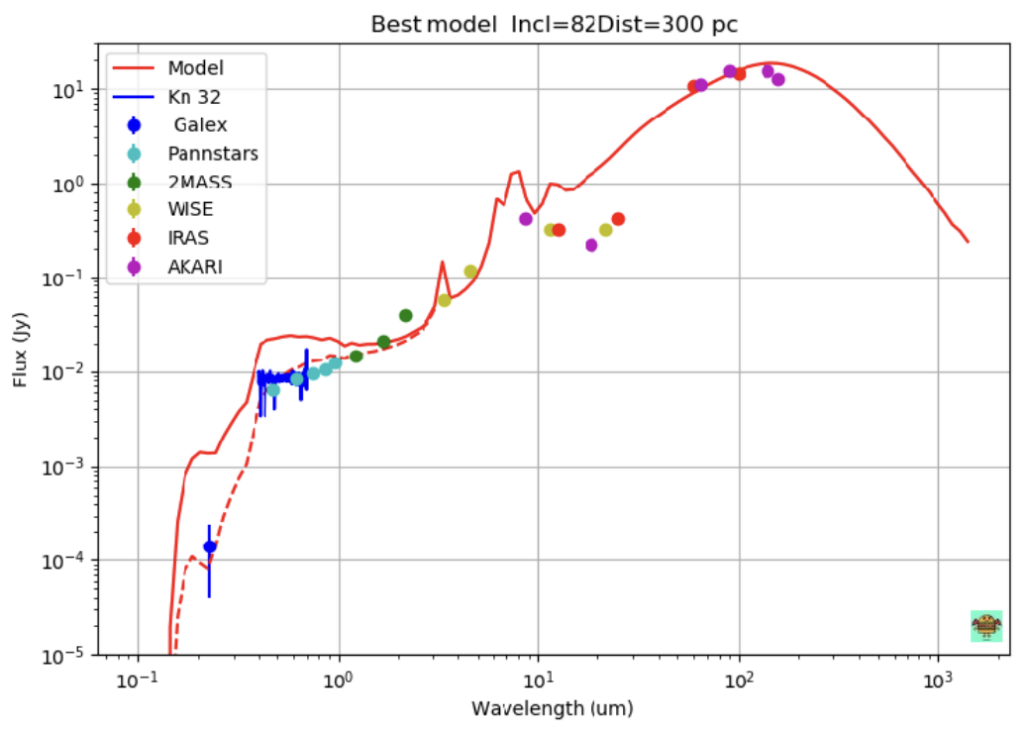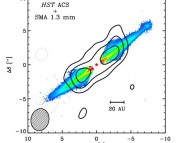Title: Dracula’s Chivito: discovery of a large edge-on protoplanetary disk with Pan-STARRS
Authors: Ciprian T. Berghea, Ammar Bayyari, Michael L. Sitko, Jeremy J. Drake, Ana Mosquera, Cecilia Garraffo, Thomas Petit, Ray W. Russell, Korash D. Assani
First Author’s Institution: U.S. Naval Observatory (USNO), 3450 Massachusetts Avenue NW, Washington, DC 20392, USA
Status: Submitted to ApJL [open access on arXiv]
Where planets are born
Studying protoplanetary disks helps us understand how planets, including those in our solar system, are born. These disks are vast and flared structures, consisting of dust and gas orbiting a young star. Protoplanetary disks contain the remnants of the stellar birth process, where a collapsing molecular cloud gives rise to a central star surrounded by a swirling disk of material. Protoplanetary disks are vital to observe as they are the birth sites of planets. The tiny dust particles come together, sticking and forming larger bodies. This process, influenced by gravity, gas, and radiation, leads to the birth of planets in developing planetary systems.
Meet the Vampire Sub
This paper features a large edge-on protoplanetary disk which was stumbled upon when going through images by Pan-STARRS (hereafter PS1) as a part of a study of active galactic nuclei candidates. This disk is one of the largest known in the sky and is oriented edge-on, completely obscuring its central star. Associated with a source of infrared light in the same region of the sky, IRAS 23077+6707, it spans approximately 11″ in apparent size, with a very faint structure in the disk’s northern part extending out to about 18′. It is possibly the largest protoplanetary disk (by angular extent) discovered to date. The structure of this disk was reminiscent of the popular Gomez’s Hamburger that is not associated with any star forming region, just like the subject of this paper. The similarity to a sandwich, along with the fangs-like structure in the northern part of the disk as seen in the images in Figure 1, earned the IRAS 23077+6707 protoplanetary disk the name “Dracula’s Chivito” (chivito is a type of sandwich and the national dish of Uruguay, where one of the co-authors is from).
[ALT TEXT: Left: Pan-STARRS image of Dracule’s Chivito with a bright blue-purple light in the center, as a structure resembling a sandwich. It has faint filaments extending out like “fangs”. Right: A model of the disk on the left, which looks smoother and the fangs are shown to be a part of larger disk envelope, which is a hazy blue light emanating from the disk in the center which has a pink hue]
Decoding DraChi
Analysis: Images of Dracula’s Chivito (henceforth referred to as DraChi) were obtained in the grizy filters of PS-1 (Figure 1). These and data from GALEX (UV), 2MASS (IR), IRAS (IR), and AKARI/IRC (IR) were used for photometric analysis, i.e. flux or brightness measurements. This was used to construct the spectral energy distribution (SED) of the plot (Figure 2), together with a radiative transfer model generated using the code HOCHUNK3D (Figure 1). Radiative transfer models help us understand the disk geometry and how light is scattered by the dust grains in the disk. This light, which we see along our line of sight, is plotted as an SED. SEDs give information about how much energy an object gives off at different wavelengths.
Distance: It is hard to estimate DraChi’s distance because it is not associated with a known star forming region. Accurate distances to local molecular clouds are vital to locating protoplanetary disks and comprehending planet formation processes. Therefore, using the Gaia DR3 data for nearby stars, the extinction of the disk was estimated to find the distance to the nearest interstellar clouds, and DraChi is hence estimated to be 300 parsecs away.
Basic Properties: The SED suggests that the host star of the disk to be a pre-main sequence star of type A with a temperature of about 6500 – 8500 K. The images of the disk, and the resultant radiative transfer model constrain the disk inclination between 80º and 84º. The scale height of the disk is about 0.05 – 0.1 at a radius of 500 au (astronomical units), where 1 au is the distance from the Earth to the Sun. Using the distance, and the angular extent of the disk in the sky, the disk radius is estimated to be 1650 au. The radiative transfer model, based on the scattering of the light, quantifies the dust mass of the disk to be about 0.2 times that of the Sun.
The Fangs: Two “fang-like” features are noticed in the northern part of the disk, which were also reproduced in the model of the disk. The “fangs” closely resemble the “edge” of the shadow created by the disk in the bright surrounding envelope. They could be filaments due to a possible outflow from the central part of the disk, which is characteristic of a young disk at the end of the Class I phase (~0.5 million years old). It is possible that the fangs are present in the south, but this region is likely obscured in the images from PS1 and could be perhaps seen in infrared (longer wavelength) imaging.
[ALT TEXT: A plot of the spectral energy distribution of the disk as obtained from brightness measurements from different instruments and compared to the spectrum from the model. The different colored dots representing data are mostly fit well by the model except in near and mid infrared wavelengths (from about 10 to 50 microns)]
Is DraChi the only one?
The short answer is no. DraChi is certainly different from other protoplanetary disks, given its size and being away from any known star forming regions. But the existence of Gomez’s Hamburger proves there are more such disks awaiting discovery. A disk as young as DraChi is vital to understanding planet formation in its earlier stages, and its large size makes for interesting future observations using more sensitive instruments.
Astrobite edited by Kylee Carden and Jessie Thwaites
Featured image credit: Berghea et al. 2024






